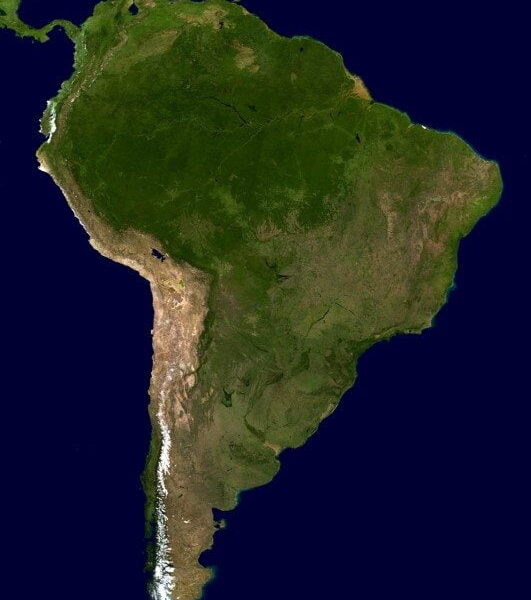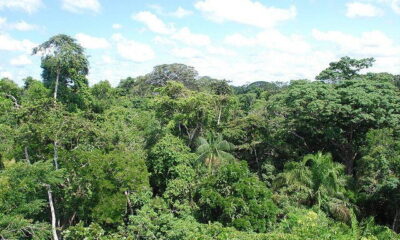

Economy
Large South American governments could take more climate action: analysis
While Brazil and Peru have better climate plans than Chile or Argentina, none of them have been rated as “sufficient” by the Climate Action Tracker (CAT), which released analyses of the four South American country climate targets today.
The CAT – an analysis by four European research organisations – has rated Brazil and Peru’s submissions to the UN as “medium” and has given an “inadequate” rating to both Argentina and Chile. Together, these four countries make up 72% of South America’s greenhouse gas emissions, excluding Land use, land-use change and forestry (LULUCF).
The CAT’s “medium” rating indicates that both Brazil and Peru’s climate plans are at the least ambitious end of what would be a fair contribution, and are inconsistent with limiting warming to below 2°C unless other countries make much deeper reductions and comparably greater effort.
For Argentina and Chile, an “inadequate” rating is inconsistent with limiting warming to below 2°C: if all countries were to adopt this lower level of ambition, global warming would likely exceed 3-4°C this century.
“None of these countries will be immune to the effects of climate change. An increase in warming of 2˚C would have severe impacts on all four of them, and on the rest of the continent,” said Dr. Marcia Rocha, Head of the Climate Policy team at Climate Analytics.
“Yet instead of taking action commensurate with the size of the threat, these governments are largely sticking with their current policies, which are heading in the wrong direction.”
“These four South American climate targets are collectively disappointing, with this region extremely vulnerable to climate impacts and many already being observed, now would be the time to really ramp up policies and ambition,” said Bill Hare, CEO of Climate Analytics.
“Now is not the time to simply put forward no more than what is already being done or planned, the world needs real ambition for Paris, and it would be a very important symbol if these countries were able to increase their climate action by the time we get to Paris.”
Detail for each country below.
Climate change impacts are expected to hit Brazil hard. The Amazon has already been hit by severe droughts, and 2˚C of warming is likely to increase these, and generally prolong the dry season.
This could accelerate forest dieback, in particular at the yet higher warming levels associated with Brazil’s INDC rating. Sea levels are expected to rise higher around Brazilian coastlines: with a 4˚C warming, big cities like Rio de Janeiro and Recife could be hit by more than 60cm of sea level rise by end of century.
Brazil is one of only two major developing economies (2) assessed by the CAT with a “hard” climate target – ie one based on reductions below a historical year as opposed to reductions “below business-as-usual,” or the emissions intensity of its economy.
Its target is to reduce net greenhouse gas emissions by 37% below 2005 levels by 2025, with an “indicative contribution” to reduce emissions by 43% below 2005 levels by 2030. Both targets include forestry and land use (LULUCF).
Brazil, home to the largest share (60%) of the Amazon rainforest, has already made huge steps in reducing its previously soaring rates of deforestation, cutting them by 85% between 2005 and 2012.
But while the government intends to fulfil its INDC through moves like a 45% renewable energy share, this will still result in Brazil’s energy emissions increasing. It is already very close to meeting its new climate under its current laws.
To reach its renewables target, Brazil would only have to make a small improvement compared with today’s regulations. Meanwhile, Brazil’s emissions from other sectors (energy, industry and agriculture) are still set to rise.
“Brazil has a large share of hydro power, yet its energy market is projected to increase by more than 50% between 2012 and 2030. While it is good that renewable energy share is set to grow, Brazil needs to be careful it doesn’t recarbonise its electricity sector,” said Dr Rocha.
Climate change is likely to hit Peru hard: 2˚C of warming is likely to see 90% of its glaciers disappear, bringing massive water shortages to cities like Lima during the dry season. When it comes to climate change impacts on fisheries, Peru is listed as one of the world’s most vulnerable countries.
Peru’s climate target also receives a CAT “medium” rating for its unconditional target of a reduction by 20% below business-as-usual (BAU) by 2030, shifting up to 30% with financial help.
Peru hosts about 260,000 square miles of forest – the largest area of the Amazon rainforest after Brazil. The Amazon is poised to become one of the 11 regions in the world to have more deforestation and forest degradation than anywhere else in 2030, and Peru’s contribution is not insignificant.
The expansion of the palm oil industry, agriculture, illegal logging and informal mining has are major drivers of deforestation in the Andean-Amazon countries like Peru, where emissions from deforestation are projected to soar at a rate not seen before in the country’s history (from 92.6 MtCO2e in 2010 to 159 MtCO2e in 2030). Peru will need to implement more policies to reach its climate targets.
“With its current deforestation rates, it is difficult to see how Peru is going to meet its climate target, especially its 2021 zero deforestation goal.The country is also likely to face water shortages from glacier melt that will impact on cities and agriculture,” said Juan Pablo Osornio, of Ecofys.
Chile also faces glacial melt and water shortages under 2˚C of warming, but not quite as extreme as Peru. However, its low-lying cities of Valparaiso and Antofagasta would see sea level rise of up to more than half a metre by the end of the century (in a 4˚C warming world), and a 30% reduction in fisheries.
Chile has set an unconditional target of a 30% reduction of GHG emissions-intensity of GDP below 2007 levels by 2030, which the CAT has rated “inadequate.”
Chile’s INDC is less ambitious than the two options in the draft its Ministry for the Environment released in December 2014. Of significant concern is that the final target sent to the UN does not set a goal for 2025, and the level set for 2030 is far from a 2° C pathway.
“Chile is a good example of how, if the Paris agreement were to set targets only for 2025, inadequate efforts such as Chile’s could be improved for a 2030 dateline,” said Juan Pablo Osornio.
Argentina has submitted target of reducing GHG emissions including land use by 15 % below Business As Usual by 2030 including LULUCF or 16% by 2030 excluding LULUCF (equivalent to 129-131% above 1990 levels and 50-52% above 2010 levels excluding LULUCF).
The CAT has rated Argentina’s target as “inadequate.” Moreover, Argentina has reserved the right to adjust its target, adding a high level of uncertainty to its contribution to the 2015 agreement.
Argentina is likely to be hit hard by global warming, where average temperature increases are likely to be you will much higher than the global average. For example, average temperatures in a 2˚C world will be 0.5˚C higher and, in a 4˚C world, are likely to be two degrees higher, ie 6˚C. Global warming for Argentina, a country heavily dependent on agriculture, is likely to reduce crop yields and reduce water availability.
Argentina is likely to meet its proposed targets without taking any further action – ie, under policies it has in place now. Yet emissions are projected to grow significantly – by than 25% from 2012-2030.
By 2030, the energy, agriculture and cattle-ranching sectors will account for more than 87% of the country’s total emissions, with huge growth (35%) from the agricultural sector between now and 2030.
“Argentina has the potential to step up and at least meet its more ambitious conditional pledge. For a country with such large emissions, and facing quite extreme impacts from global warming, it is disappointing to see such an inadequate effort,” said Dr Rocha.


 Environment10 months ago
Environment10 months agoAre Polymer Banknotes: an Eco-Friendly Trend or a Groundswell?

 Environment11 months ago
Environment11 months agoEco-Friendly Home Improvements: Top 7 Upgrades for 2025

 Features9 months ago
Features9 months agoEco-Friendly Cryptocurrencies: Sustainable Investment Choices

 Features10 months ago
Features10 months agoEco-Friendly Crypto Traders Must Find the Right Exchange





























